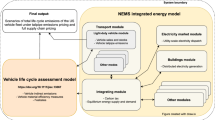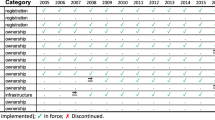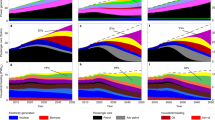Abstract
Electric vehicles have a potential to lower greenhouse gas emissions but still face challenges. This study asks what can be learned from the US automobile history. In 1900, there were three equal contenders in the US automotive industry: gasoline, electric and steam cars. Only a decade later, the gasoline car had achieved a crushing dominance. This dominance is often attributed to techno-economic factors, such as an innate inferiority of electric cars. Meanwhile, the role of the infrastructures is not well understood. This study presents evidence on the mechanisms behind the rise of gasoline vehicles, using a database of more than 36,000 passenger car models. We estimated econometric models to explain the technology choice of car producers, which show that the slow expansion of electricity infrastructure had a key impact. We estimate that a 15 or 20 year earlier diffusion of electricity grids would have tipped the balance in favour of electric vehicles, most notably in metropolitan areas. In the context of the current climate crisis, the results support the notion that large-scale investment in infrastructure is critical to achieve sustainable socio-technological transitions.
This is a preview of subscription content, access via your institution
Access options
Access Nature and 54 other Nature Portfolio journals
Get Nature+, our best-value online-access subscription
$29.99 / 30 days
cancel any time
Subscribe to this journal
Receive 12 digital issues and online access to articles
$119.00 per year
only $9.92 per issue
Buy this article
- Purchase on Springer Link
- Instant access to full article PDF
Prices may be subject to local taxes which are calculated during checkout




Similar content being viewed by others
Data availability
The data that support the figures and other findings within this article are available at https://doi.org/10.5878/j8af-b705. Data for Supplementary Fig. 2 and Supplementary Notes 8 and 9 are available upon request from the corresponding author. Source data are provided with this paper.
Code availability
Most data cleaning and analysis was performed using Stata. Maps were produced using ArcGIS and Moran’s I using R statistical software and spdep packages. The code that supports the findings of the main study is available at https://doi.org/10.5878/j8af-b705. The code that supports supplementary results are available upon request from the corresponding author.
References
Brouwer, A. S., Kuramochi, T., van den Broek, M. & Faaij, A. Fulfilling the electricity demand of electric vehicles in the long term future: an evaluation of centralised and decentralised power supply systems. Appl. Energy 107, 33–51 (2013).
Needell, Z. A., McNerney, J., Chang, M. T. & Trancik, J. E. Potential for widespread electrification of personal vehicle travel in the United States. Nat. Energy 1, 16112 (2016).
Plötz, P., Funke, S., Jochem, P. & Wietschel, M. CO2 mitigation potential of plug-in hybrid electric vehicles larger than expected. Sci. Rep. 7, 16493 (2017).
CO2 Emissions from Transport (% of Total Fuel Combustion) (World Bank, 2014); https://data.worldbank.org/indicator/EN.CO2.TRAN.ZS?end=2014&start=1960&view=chart&year=1966
Nykvist, B. & Nilsson, M. Rapidly falling costs of battery packs for electric vehicles. Nat. Clim. Change 5, 329–332 (2015).
Tran, M., Banister, D., Bishop, J. D. & McCulloch, M. D. Realizing the electric-vehicle revolution. Nat. Clim. Change 2, 328–333 (2012).
Kieckhäfer, K., Wachter, K. & Spengler, T. S. Analyzing manufacturers’ impact on green products’ market diffusion—the case of electric vehicles. J. Clean. Prod. 162, S11–S25 (2017).
Wesseling, J. H., Faber, J. & Hekkert, M. P. How competitive forces sustain electric vehicle development. Technol. Forecast. Soc. Change 81, 154–164 (2014).
Wesseling, J. H., Niesten, E. M. M., Faber, J. & Hekkert, M. P. Business strategies of incumbents in the market for electric vehicles: opportunities and incentives for sustainable innovation. Bus. Strateg. Environ. 24, 518–531 (2014).
Lynes, J. Dealerships are a tipping point. Nat. Energy 3, 457–458 (2018).
de Rubens, G. Z., Noel, L. & Sovacool, B. K. Dismissive and deceptive car dealerships create barriers to electric vehicle adoption at the point of sale. Nat. Energy 3, 501–507 (2018).
Merriam, W. R. Twelfth Census of the United States, taken in the Year 1900. Census Reports. Vol. X. Manufacturers, Part 4 (US Census Office, 1902).
Mom, G. The Electric Vehicle: Technology and Expectations in the Automobile Age (Johns Hopkins Univ. Press, 2004).
Schiffer, M. B. Taking Charge: The Electric Automobile in America (Smithsonian Institution, 1994).
Flink, J. J. The Automobile Age (MIT, 1990).
Kirsch, D. A. The Electric Vehicle and the Burden of History (Rutgers Univ. Press, 2000).
Geels, F. W. The dynamics of transitions in socio-technical systems: a multi-level analysis of the transition pathway from horse-drawn carriages to automobiles (1860–1930). Technol. Anal. Strateg. Manage. 17, 445–476 (2005).
Scharff, V. Taking the Wheel: Women and the Coming of the Motor Age (Univ. New Mexico Press, 1992).
Mom, G. P. & Kirsch, D. A. Technologies in tension: horses, electric trucks, and the motorization of American cities, 1900–1925. Technol. Cult. 42, 489–518 (2001).
Cowan, R. & Hultén, S. Escaping lock-in: the case of the electric vehicle. Technol. Forecast. Soc. Change 53, 61–79 (1996).
Mom, G. P. Civilized adventure as a remedy for nervous times: early automobilism and fin de siècle culture. Hist. Technol. 23, 157–190 (2003).
Ivory, C. & Genus, A. Symbolic consumption, signification and the ’lockout’ of electric cars, 1885–1914. Bus. Hist. 52, 1107–1122 (2010).
Raff, D. M. & Trajtenberg, M. in The Economics of New Goods (eds Bresnahan, T. F. & Gordon, R. J.) 71–108 (Univ. Chicago Press, 1996).
Klepper, S. The origin and growth of industry clusters: the making of Silicon Valley and Detroit. J. Urban Econ. 67, 15–32 (2010).
Fogel, R. W. Railroads and American Economic Growth (John Hopkins, 1964).
Mood, C. Logistic regression: why we cannot do what we think we can do, and what we can do about it. Eur. Sociol. Rev. 26, 67–82 (2010).
Bilotkach, V. & Mills, M. Simple economics of electric vehicle adoption. Proc. Soc. Behav. Sci. 54, 979–988 (2012).
Cecere, G., Corrocher, N. & Guerzoni, M. Price or performance? A probabilistic choice analysis of the intention to buy electric vehicles in European countries. Energy Policy 118, 19–32 (2018).
Sierzchula, W., Bakker, S., Maat, K. & Van Wee, B. The influence of financial incentives and other socio-economic factors on electric vehicle adoption. Energy Policy 68, 183–194 (2014).
Katz, M. L. & Shapiro, C. Technology adoption in the presence of network externalities. J. Polit. Econ. 94, 822–841 (1986).
Dahmén, E. ‘Development blocks’ in industrial economics. Scan. Econ. Hist. Review 36, 3–14 (1988).
Carlsson, B. & Stankiewicz, R. On the nature, function and composition of technological systems. J. Evol. Econ. 1, 93–118 (1991).
Brynjolfsson, E. & Kemerer, C. F. Network externalities in microcomputer software: an econometric analysis of the spreadsheet market. Manage. Sci. 42, 1627–1647 (1996).
Hughes, T. P. Networks of Power: Electrification in Western Society, 1880–1930 (John Hopkins Univ. Press, 1983).
Tobey, R. C. Technology as Freedom: the New Deal and the Electrical Modernization of the American Home (Univ. California Press, 1996).
Jones, H. P., Hole, D. G. & Zavaleta, E. S. Harnessing nature to help people adapt to climate change. Nat. Clim. Change 2, 504–509 (2012).
Thacker, S. et al. Infrastructure for sustainable development. Nat. Sustain. 2, 324–331 (2019).
Kimes, B., Clark, H., Dunwoodie, R. & Marvin, K. Standard Catalog of American Cars 1805–1942 (Krause, 1996).
Klepper, S. The capabilities of new firms and the evolution of the US automobile industry. Ind. Corp. Change 11, 645–666 (2002).
Manson, S. et al. IPUMS National Historical Geographic Information System: Version 12.0 (Univ. Minnesota, 2017); https://www.ipums.org/projects/ipums-nhgis/d050.v12.0
Arthur, W. B. Competing technologies, increasing returns, and lock-in by historical events. Econ. J. 99, 116–131 (1989).
David, P. Zvi Griliches and the Economics of Technology Diffusion: Adoption of Innovations, Investment Lags, and Productivity Growth. Discussion paper 09-016 (Stanford Institute for Economic Policy Research, 2015).
Woolf, A. G. Electricity, productivity, and labor saving: American manufacturing, 1900–1929. Explorations in Economic History 21, 176 (1984).
United States Bureau of the Census Central Electric Light and Power Stations, 1902, 1907, 1912, 1917, 1922, 1927, 1932, 1937 (US Government Printing Office, 1905, 1910, 1915, 1920, 1925, 1930, 1934, 1939).
Powers’ Central Station Directory and Buyers’ Manual (E.L. Powers Company, 1900).
US Department of Agriculture Public Road Mileage and Revenues in the United States, 1914 Bulletin No. 30 (US Government Printing Office, 1917).
Michaels, G. The long term consequences of resource-based specialisation. Econ. J. 121, 31–57 (2010).
Jordà, Ò., Schularick, M. & Taylor, A. M. in NBER Macroeconomics Annual 2016 Vol. 31 (eds Eichenbaum, M. & Parker, J. A.) 213–263 (Univ. Chicago Press, 2017).
Koh, H. & Magee, C. L. A functional approach for studying technological progress: extension to energy technology. Technol. Forecast. Soc. Change 75, 735–758 (2008).
Public Road Mileage, Lane-Miles and VMT, 1900–2017 Chart VMT421c (US Department of Transportation, 2017); https://www.fhwa.dot.gov/policyinformation/statistics/2017/vmt421c.cfm
Williamson, H. F. The American Petroleum Industry: The Age of Energy, 1899–1959 (Northwestern Univ. Press, 1963).
US Federal Highway Administration Highway Statistics, Summary to 1965 (US Government Printing Office, 1967).
Acknowledgements
We gratefully acknowledge funding support from the Jan Wallander and Tom Hedelius foundation (grant nos W2015-0445 (J.T.) and W2017-0025 (H.N.)).
Author information
Authors and Affiliations
Contributions
J.T. conceived, designed and analysed the hedonic price and logistic regressions and curated the main data. H.N. conceived, designed and analysed the spatial location and spatial autocorrelation and performed data curation. Both authors wrote and revised the manuscript and discussed the results.
Corresponding author
Ethics declarations
Competing interests
The authors declare no competing interests.
Additional information
Peer review information Nature Energy thanks Massimo Guarnieri, Gijs Mom and the other, anonymous, reviewer(s) for their contribution to the peer review of this work.
Publisher’s note Springer Nature remains neutral with regard to jurisdictional claims in published maps and institutional affiliations.
Supplementary information
Supplementary Information
Supplementary Notes 1–9, Figs. 1–8 and Tables 1–11.
Source data
Source Data Fig. 1
Statistical source data for Fig. 1.
Source Data Fig. 2
Statistical source data for Fig. 2.
Source Data Fig. 4
Statistical source data for Fig. 4.
Rights and permissions
About this article
Cite this article
Taalbi, J., Nielsen, H. The role of energy infrastructure in shaping early adoption of electric and gasoline cars. Nat Energy 6, 970–976 (2021). https://doi.org/10.1038/s41560-021-00898-3
Received:
Accepted:
Published:
Issue Date:
DOI: https://doi.org/10.1038/s41560-021-00898-3
This article is cited by
-
Effects of diversified subsidies on the decisions of infrastructure operators considering charging infrastructure construction level and price sensitivity
Environment, Development and Sustainability (2023)
-
Policies to Promote Carbon Capture and Storage Technologies
Environmental and Resource Economics (2023)
-
Homo Viator 2020s: electrified and internet-based personal mobilities
GeoJournal (2022)
-
Levelized costs of the energy chains of new energy vehicles targeted at carbon neutrality in China
Frontiers of Engineering Management (2022)
-
Infrastructure killed the electric car
Nature Energy (2021)



